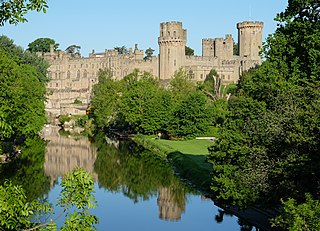
A wax museum or waxworks usually consists of a collection of wax sculptures representing famous people from history and contemporary personalities exhibited in lifelike poses, wearing real clothes.

Madame Tussauds is a wax museum founded in 1835 by French wax sculptor Marie Tussaud in London, spawning similar museums in major cities around the world. While it used to be spelled as "Madame Tussaud's", the apostrophe is no longer used.

Warwick Castle is a medieval castle developed from a wooden fort, originally built by William the Conqueror during 1068. Warwick is the county town of Warwickshire, England, situated on a meander of the River Avon. The original wooden motte-and-bailey castle was rebuilt in stone during the 12th century. During the Hundred Years War, the facade opposite the town was refortified, resulting in one of the most recognisable examples of 14th-century military architecture. It was used as a stronghold until the early 17th century, when it was granted to Sir Fulke Greville by James I in 1604. Greville converted it to a country house, and it was owned by the Greville family until 1978, when it was bought by the Tussauds Group.

John George Haigh, commonly known as the Acid Bath Murderer, was an English serial killer convicted for the murder of six people, although he claimed to have killed nine. Haigh battered to death or shot his victims and disposed of their bodies using sulphuric acid before forging their signatures so he could sell their possessions and collect large sums of money. His actions were the subject of the television film A Is for Acid.

Norwich Castle is a medieval royal fortification in the city of Norwich, in the English county of Norfolk. William the Conqueror (1066–1087) ordered its construction in the aftermath of the Norman Conquest of England. The castle was used as a gaol from 1220 to 1887. In 1894 the Norwich Museum moved to Norwich Castle. The museum and art gallery holds significant objects from the region, especially works of art, archaeological finds and natural history specimens.

Gepps Cross is a suburb and major road intersection in the north of Adelaide, South Australia. Gepps Cross is traditionally seen as the end of the inner suburbs and the start of the outer northern suburbs, as it was home to a major abattoir with holding yards and other open space. It is the first significant open space encountered after the North Parklands. It retains the open nature, even with warehouses, a velodrome, hockey stadium, Adelaide Raiders – a Croatian soccer club, and karate training facilities.

Homicidal is a 1961 American horror-thriller film produced and directed by William Castle, and starring Glenn Corbett, Patricia Breslin, Eugenie Leontovich, Alan Bunce and Jean Arless. The film follows a murderous woman in a small California town whose presence unearths secrets concerning a prominent local family.

William Frederick Yeames was a British painter best known for his oil-on-canvas "And When Did You Last See Your Father?", which depicts the son of a Royalist being questioned by Parliamentarians during the English Civil War.

Blanche Fury is a 1948 British Technicolor drama film directed by Marc Allégret and starring Valerie Hobson, Stewart Granger and Michael Gough. It was adapted from a 1939 novel of the same title by Joseph Shearing. In Victorian era England, two schemers will stop at nothing to acquire the Fury estate, even murder.

Roseland Plantation is a historic plantation complex site in Faunsdale, Alabama. The site is situated on a low hill at the end of a long driveway on the overgrown estate. It was added to the National Register of Historic Places on January 20, 1994, as a part of the Plantation Houses of the Alabama Canebrake and Their Associated Outbuildings Multiple Property Submission.
Sir John Barnard Byles was a British barrister, judge and author of books on law and the economy. He published an influential text on bills of exchange in 1829, commonly referred to as "Byles on Bills".

Broadstone lies close to the small village of Gateside in North Ayrshire, Scotland about half a mile east of Beith in the old Barony of Giffen.

The Isaac Young House is an historic wood frame house on Pinesbridge Road in New Castle, New York, United States. It was built about 1872 in the Second Empire style. Its owner, Isaac Young, was a descendant of early settlers in the area. He chose the Second Empire style, more commonly found in cities and villages than on farms, possibly as a way of demonstrating his affluence. The present structure appears to incorporate parts of a vernacular late 18th-century farmhouse, leaving several anomalies in the current house as a result. The house's position atop a low hill would have, in its time, given it a commanding view of the region, including the Hudson River and New York City's skyline.


The Chamber of Horrors is an exhibition at Madame Tussauds in London, being an exhibition of waxworks of notorious murderers and other infamous historical figures. The gallery first opened as a "Separate Room" in Marie Tussaud's 1802 exhibition in London and quickly became a success as it showed historical personalities and artefacts rather than the freaks of nature popular in other waxworks of the day. It closed in April 2016 but reopened 6 years later in October 2022.

The Shirehall is a municipal facility in Market Avenue, Norwich, Norfolk. It is a Grade II listed building.
Lorenz Beha (c.1825–1853) was a German watchmaker and silversmith living in Britain who was murdered in Norfolk in 1853.

Amisfield House was a substantial Palladian mansion near Haddington, East Lothian.


















